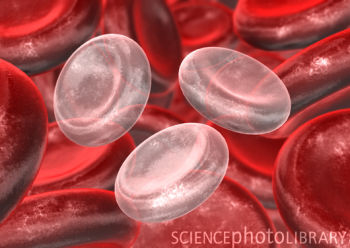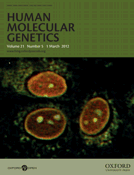
最近,中科院上海生科院营养科学研究所的研究人员锁定了一个与中国人贫血发病直接相关的基因,它的功能强弱决定了人是否容易得缺铁性贫血。这是迄今发现的第一个人类的“缺铁性贫血风险基因”。
“在临床治疗中,有的缺铁性贫血病人很容易治愈,但有些贫血患者却迁延不愈,基因很可能是引起这种差别的原因之一。”研究主导者之一、中国科学院营养所研究员王福俤说。这次,课题组在对超过2000例中国中老年女性进行深入的流行病研究后,确认TMPRSS6是对人群有直接作用的“缺铁贫血风险基因”。
人体中有一位掌管铁元素代谢的“总管”,被称为“铁调素(Hepcidin)”:当人体需要铁时,它保持静默,让细胞中的“铁泵”蛋白(Fpn1)从食物、报废的红细胞中,吸收铁元素进行新陈代谢;一旦人体中铁元素过量,它则四处行动,将“铁泵”关闭。而“缺铁贫血基因”的本领就是压制这位“铁总管”,不让它关闭“铁泵”。
王福俤研究组成员关注了TMPRSS6基因在人群中的两种形态,发现结构上仅存在细微的差别。但这却造成了它们对“铁总管”压制能力的不同。其中一种对“铁总管”的压制能力较弱,导致即使人体铁元素没有过量,“铁总管”依然在关闭“铁泵”,阻止人体吸收铁——这部分人群更容易得缺铁性贫血,据统计其风险较正常人高出近80%!
论文主要参与者、营养所博士生安鹏告诉记者,这类人由于对铁的吸收效率较低,需要更多营养来避免贫血,但在营养过剩时,这种“低效率”反而降低了他们得糖尿病的风险。“这一人群更不易得2型糖尿病。”王福俤认为,可能较差的铁吸收能力,在一定程度上阻止了过多铁元素进入人体,起到保护胰腺等器官的作用。
目前,研究的相关论文已发表在《人类分子遗传学》和《美国临床营养学期刊》上。

TMPRSS6, but not TF, TFR2, or BMP2 Variants are Associated with Increased Risk of Iron Deficiency Anemia
Peng An, Qian Wu, Hao Wang, Yu Guan, Mingdao Mu, Yijun Liao, Daizhan Zhou, Pengkun Song, Chunrong Wang, Liping Meng, Qingqing Man, Lixiang Li, Jian Zhang and Fudi Wang
A variety of conditions lead to anemia, which affects one-quarter of the world’s population. Previous genome-wide association studies revealed a number of genetic polymorphisms significantly associated with plasma iron status. To evaluate the association of genetic variants in genes involved in iron delivery and hepcidin regulation pathways with the risk of iron deficiency anemia, the following single nucleotide polymorphisms (SNPs) were genotyped in 2139 unrelated elderly Chinese women: rs3811647 (TF), rs7385804 (TFR2), rs235756 (BMP2), and rs855791(V736A) and rs4820268 (TMPRSS6, encoding matriptase-2). We identified common variants in TMPRSS6 as being genetic risk factors for both iron deficiency (ORrs855791 = 1.55, P = 4.96×10-8) and iron-deficiency anemia (ORrs855791 = 1.78, P = 8.43×10-9). TMPRSS6 polymorphisms were also associated with lower serum iron and hemoglobin levels, consistent with their associations to increased iron deficiency and anemia risk. Variants rs3811647 in TF and rs7385804 in TFR2 were associated with reduced serum iron, serum transferrin, and transferrin saturation levels; however, these variants were not associated with iron deficiency or anemia risk. Our findings suggest that TF, TFR2, and TMPRSS6 polymorphisms are significantly associated with decreased iron status, but only variants in TMPRSS6 are genetic risk factors for iron deficiency and iron-deficiency anemia.








